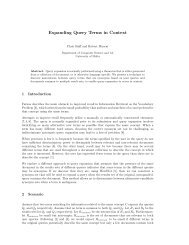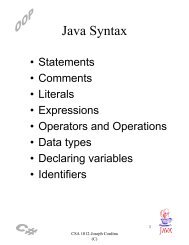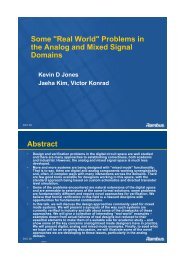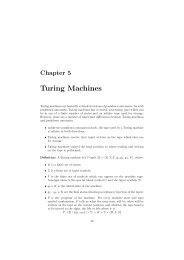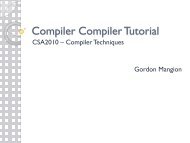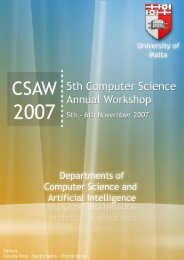Proceedings of CSAW'04 - FTP Directory Listing - University of Malta
Proceedings of CSAW'04 - FTP Directory Listing - University of Malta
Proceedings of CSAW'04 - FTP Directory Listing - University of Malta
You also want an ePaper? Increase the reach of your titles
YUMPU automatically turns print PDFs into web optimized ePapers that Google loves.
Forecasting Using Non-Linear Techniques In Time Series Analysis 21<br />
p most recent past values <strong>of</strong> itself plus an error term which incorporates everything new in the<br />
series at time t that is not explained by the past values.<br />
An autoregressive model AR is a model which depends only on the previous outputs <strong>of</strong> the system<br />
is called. A moving average model MA. Is a model which depends only on the inputs to the system.<br />
AN autoregressive-moving-average model ARMA is a model based on both inputs and output.<br />
Deterministic dynamical systems: Pure dynamical systems are described either by discrete time<br />
maps where:<br />
x n+1 = f(x n ) (n is a discrete unit <strong>of</strong> time)<br />
Or by first order ordinary differential equations:<br />
dx(t0)/dt = f(t, x(t)) (t is a real value <strong>of</strong> time)<br />
Both are descriptions <strong>of</strong> the fact that all future states <strong>of</strong> such nonlinear deterministic dynamical<br />
systems are unambiguously determined by specifying its present state at some time n (or t). Thus<br />
there also exists a deterministic forecasting function.<br />
Nonlinear deterministic dynamical systems: Another type <strong>of</strong> correlation in time is present in nonlinear<br />
deterministic dynamical systems. The underlying systems would have a deterministic nature<br />
but display irregularities. Chaos hence is an alternative source for unpredictability and irregularity<br />
in observed data, an alternative with respect to stochastic inputs.<br />
These irregularities in the measurements arise from processes which co-exist with the system under<br />
study or are due to inaccuracies (noise) in the measurement process itself.<br />
Any irregularities in the knowledge <strong>of</strong> the present state will evolve over time, in in the case <strong>of</strong> a<br />
chaotic system, will grow exponentially. However the uncertainty is amplified only at a finite rate<br />
and one can still hope to make reasonable short term forecasts.<br />
Nonlinear prediction techniques exploit correlations over time visible only by using non-linear<br />
statistics.<br />
3 Non-Linear Time Series Analysis<br />
[11] The pioneering work by Packard et al. and the seminal paper by F. Takens stimulated, about 20<br />
years ago, a new approach towards complex dynamical phenomena, nowadays called nonlinear time<br />
series analysis. Extensions towards nonlinear stochastic models and towards nonlinear statistical<br />
analysis are manifold and have been considered within various frameworks.<br />
Stationarity: [10] A signal is called stationary if all transition probabilities from one state <strong>of</strong> the<br />
system to another are independent <strong>of</strong> time within the observation period. All relevant parameters<br />
have to be kept constant and that phenomena belonging to the dynamics are contained in the time<br />
series sufficiently frequently so that the probabilities or other rule scan be inferred properly.<br />
Unpredictability: [10] <strong>of</strong> the future is the most striking feature <strong>of</strong> chaos despite a deterministic<br />
evolution. This unpredicatbiity is a consequence <strong>of</strong> the inherent instability <strong>of</strong> the solutions reflected<br />
by what is called sensitive dependence on initial conditions. The tiny deviations between the intial<br />
conditions <strong>of</strong> all the trajectories are blown up in a few time steps and every unobserved detail <strong>of</strong><br />
the state at time zero is important for the precise path <strong>of</strong> the trajectory in state space.<br />
This lead to two concepts (i) loss <strong>of</strong> information related to unpredictability; and (ii) nearby trajectories<br />
separate fast — exponentially fast over time.



